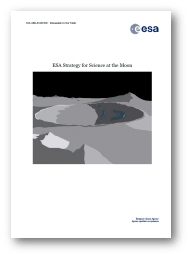ESA Strategy for Science at the Moon
Publication date: 23 May 2019
Page: 1-45
Copyright: ESA
A new era of space exploration is beginning, with multiple international and private sector actors engaged and with the Moon as its cornerstone. This renaissance in lunar exploration will offer new opportunities for science across a multitude of disciplines from planetary geology to astronomy and astrobiology whilst preparing the knowledge humanity will need to explore further into the Solar System. Recent missions and new analyses of samples retrieved during Apollo have transformed our understanding of the Moon and the science that can be performed there. We now understand the scientific importance of further exploration of the Moon to understand the origins and evolution of Earth and the cosmic context of life's emergence on Earth and our future in space.
ESA's priorities for scientific activities at the Moon in the next ten years are:
- Analysis of new and diverse samples from the Moon.
- Detection and characterisation of polar water ice and other lunar volatiles.
- Deployment of geophysical instruments and the build up a global geophysical network.
- Identification and characterisation of potential resources for future exploration.
- Deployment long wavelength radio astronomy receivers on the lunar far side.
- Characterisation of the dynamic dust, charge and plasma environment.
- Characterisation of biological sensitivity to the lunar environment.

